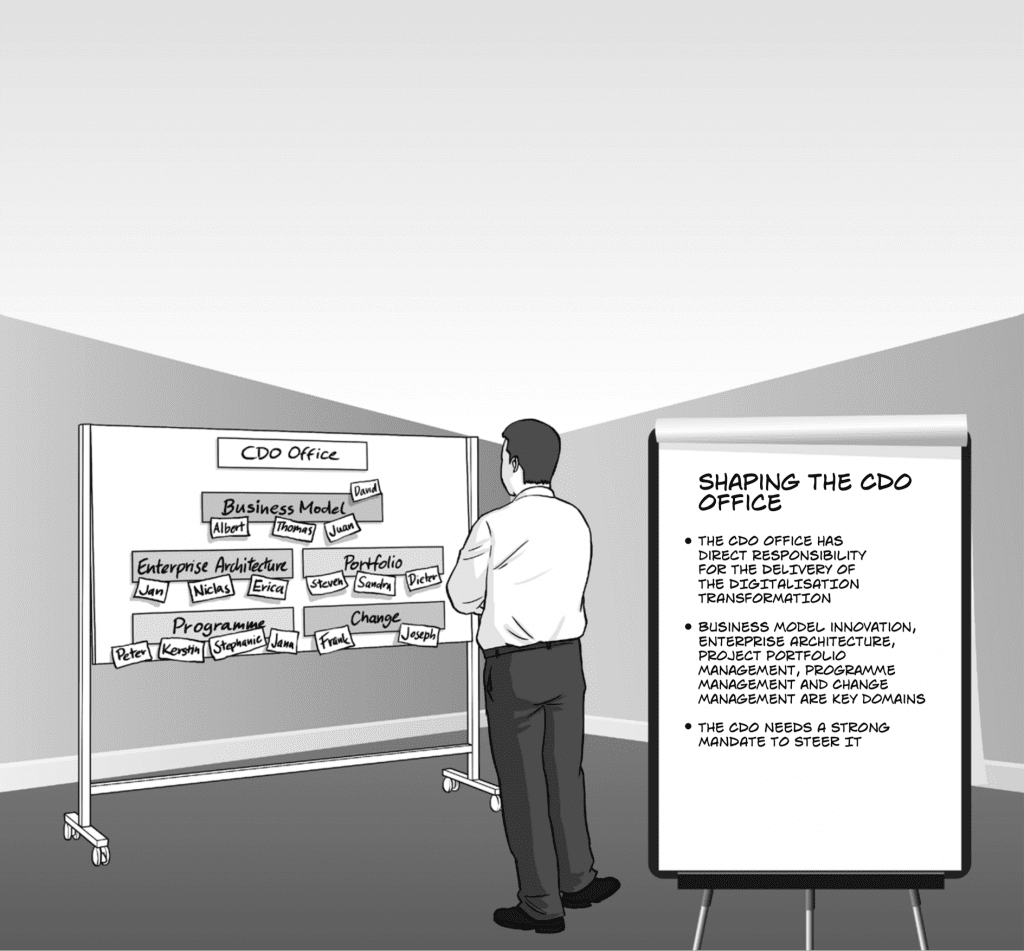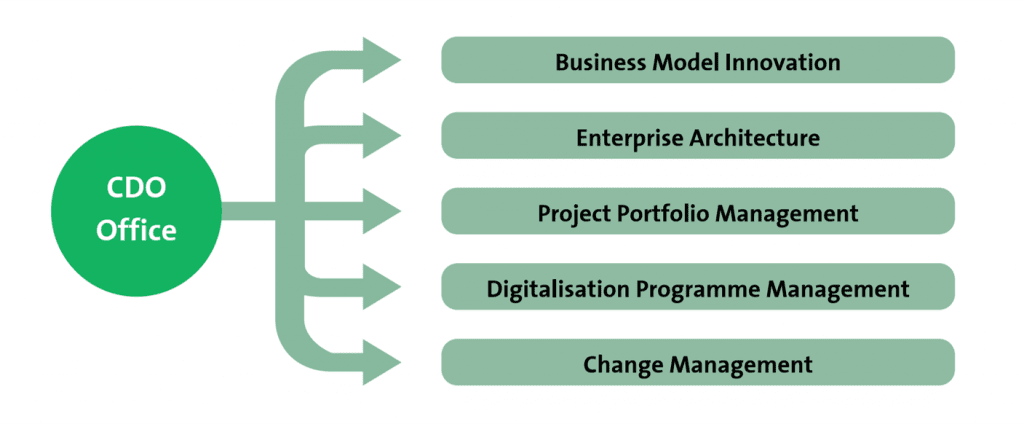We introduced the role of the Chief Digital Officer, the CDO, as the main agent for the transformation in a company transitioning from a traditional business model to a digital one. Once the initial transformation is achieved, lasting potentially several years, the CDO role might be assumed by another CxO role on the Executive Board, maybe even evolving up to the new CEO role in a digitalised business. In this section, the transient nature of the CDO role is described further.
It is the core responsibility of the CDO to build the digital capabilities of the company.
He or she needs to shape the digital transformation and drive it within the enterprise’s organisation. To achieve this, the CDO must build an effective CDO Office to deliver the functional domains that are core to digitalisation.
The CDO Office must also develop the organisational skills needed to interface tightly with other departments in the organisation; this is discussed further in the next section. The following functional domains are core to the process of digitalisation and must be integrated into the direct responsibilities of the CDO Office:
_____
[1] Caldo, C., Hoene, M., Olanrewaju, T.: ‘How winning banks refocus their IT budgets for digital’, McKinsey, 2014.
- Business Model Innovation: An agile innovation culture must be spread across the organisation, requiring significant change management input. Products and services offered by the company will benefit from innovation using detailed feedback on the needs of the customer and the potential of the market. Continuous innovation is a core capability needed to consistently stay ahead of the competition and safeguard the company from new digital entrants. The company needs to develop the capability to deal with a continuous sequence of such transformations. Furthermore, the CDO must translate the enterprise’s decision to become digital into an executable business plan and ultimately into a new business model, which must be consistently defined in all its elements (e.g., using the business canvas technique). Only after such analysis will the full impact of digitalisation on the organisation become evident. Digital targets for the organisation will need to be established, and the business portfolio reconsidered. Last, but not least, the digitalisation of the business model will have a profound impact on cash flow due to the financial needs of the transformation, on profit and loss as a reflection of new business opportunities and on the balance sheet, highlighting the value of the new business. Hence, the commercial impact of the new business model must be understood and the financing needs of the digital initiative determined.
- Enterprise Architecture: A consistent digital business model must be designed for the future shape of the company. It must be built on the basis of a deep understanding of the technical possibilities, the underlying business domain of the company and the clients’ needs and expectations. Determine the strategic direction of creating new market opportunities, reshaping the company’s products and services and adapting its delivery and distribution capabilities. By following the Enterprise Architecture approach, the company can achieve a balance between these dimensions of its operating model. Enterprise Architecture not only looks at technical architecture domains, but links them to the process and the organisational architecture of the enterprise. Only such a comprehensive approach assures that the new digital business model is balanced and attainable.
- Project Portfolio Management: Project portfolio management is the core tool the enterprise has to manage and direct investments, including the digital initiative. It is essential to ensure that the project portfolio focuses on the strategic direction laid out in the overarching digitalisation initiative.[1] During a period of such comprehensive transformation, it might even be necessary to manage the project portfolio direct from the Executive Board in order to synchronise investment decisions, deal with upcoming project issues from the top and manage project execution risk in an appropriate manner. When managing the enterprise’s project portfolio, conflicts between the needs of business-as-usual activities and those related to the comprehensive digitalisation programme will become visible and must be dealt with appropriately.
- Digitalisation Programme Management: The digitalisation initiative must be managed by a central authority. Strong leadership will be necessary for an extended period of time to drive forward this transformation in a matrix approach across the entire organisation. Programme management governance should be deployed for the digitalisation initiative, converging at the Executive Board, which manages the as-is business that in itself should not be affected. It is the CDO’s core task to make the digitalisation initiative a success, and hence he or she must oversee and direct the associated efforts.
- Change Management: Driven by the digitalisation programme, the transition to the new business model will require comprehensive change across the organisation, transforming its traditional operational model. This change must be communicated and properly managed to ensure the new model is strongly rooted in the organisation. The CDO, as the head of the transformational power of the digitalisation initiative, must personally oversee the change management efforts in the enterprise, given that the initiative fundamentally depends on the buy-in and support of all parts of the enterprise. Creating such momentum is vital, as is the proper response to fear, anxiety, risk perception and ultimately also obstruction. Being personally responsible for the change programme gives the CDO considerably more authenticity in front of the organisation, leading employees to feel inspired about the new business model. The CDO is the main evangelist of digitalisation and hence the focal point for overseeing the whole change management initiative that accompanies digitalisation.
Given the profound impact of IT on digital transformation, strong consideration should be given to giving the CDO responsibility for (or, at least, a strong influence over) the steering of the IT department’s strategic direction and resource allocation.
Depending on the size of the organisation and other considerations, it may even be beneficial to give the CDO the full responsibility for IT, as it is the main tool for implementing digital capabilities in the enterprise.




